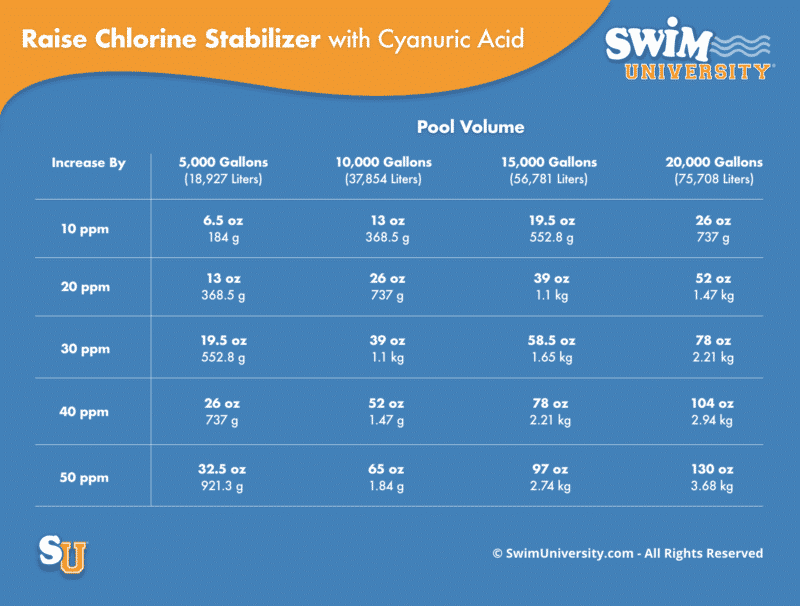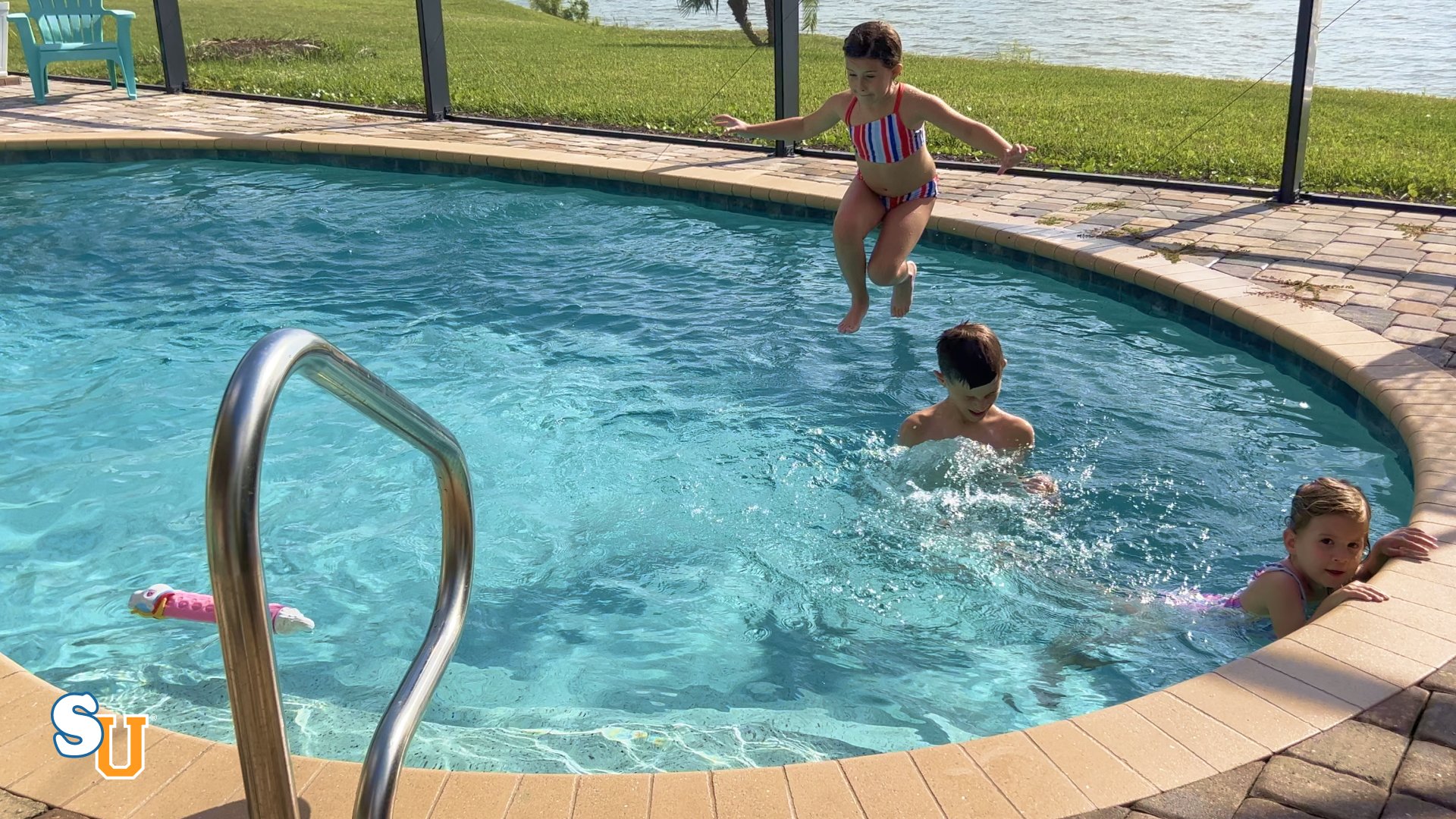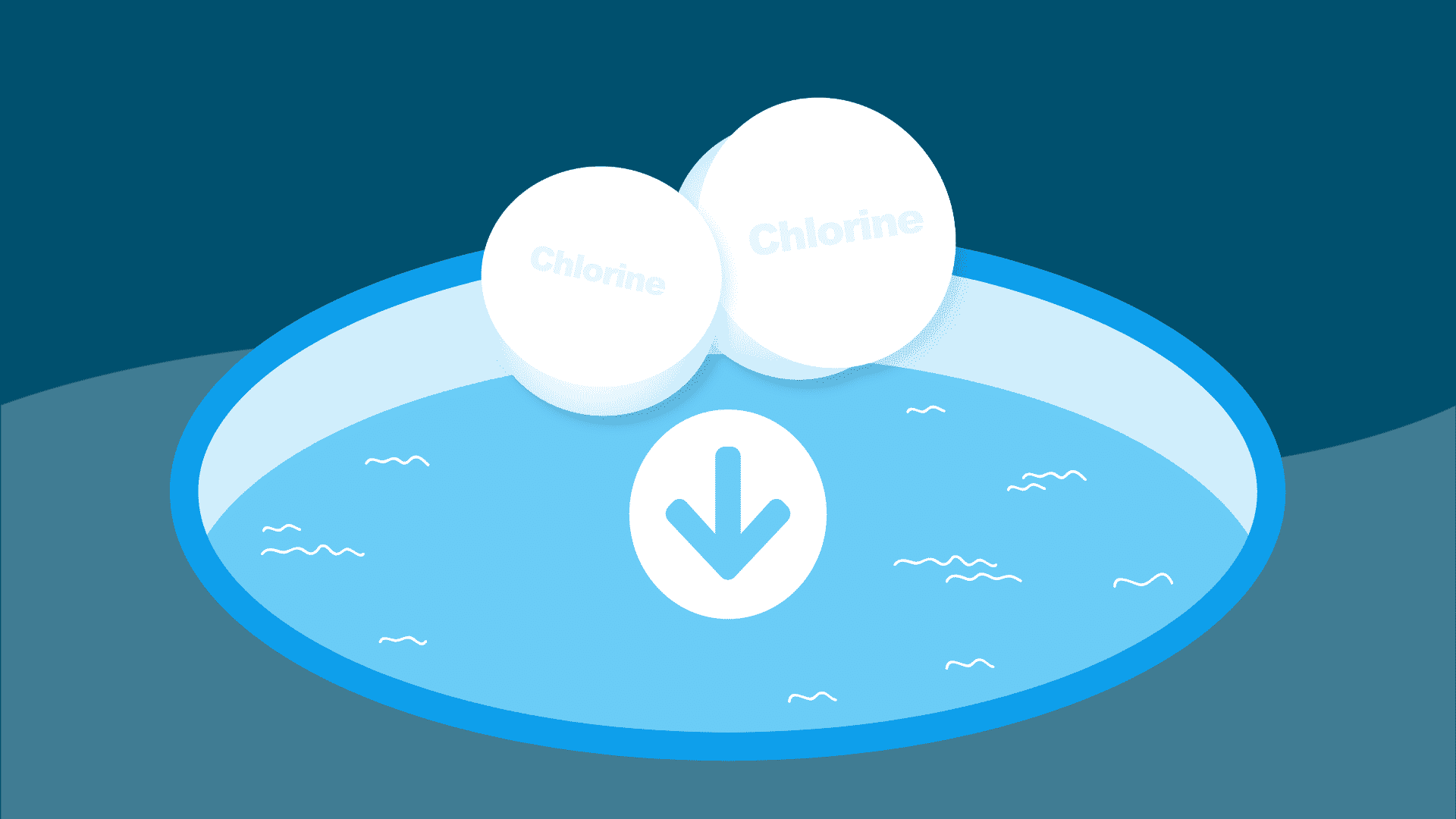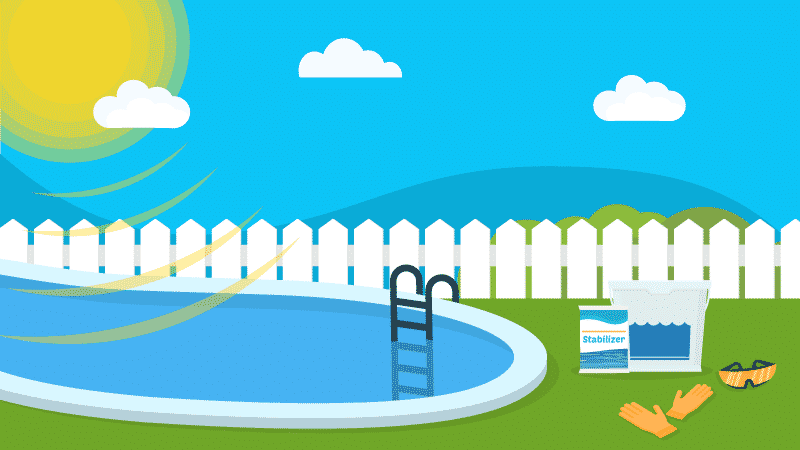How to Protect Your Chlorine Level with Pool Stabilizer
The sun and its UV rays will eat up your pool chlorine before it can clean your water. You can’t exactly move your pool inside away from the sun, but you can add a pool stabilizer to counter the sun’s effects, and keep your chlorine levels stable.
What Is Chlorine Pool Stabilizer?
Pool stabilizer is also known as pool conditioner, chlorine pool stabilizer, chlorine stabilizer, or Cyanuric Acid. And you can buy this chemical additive as either liquid or granular (powder). It’s also included in chlorine tablets or sticks (called trichlor) or shock (called dichlor). When they’re mixed together in shock or tablets, the resulting product is called stabilized chlorine.
Typically, pool owners won’t need to add any extra stabilizer separately if you’re using one of the combination products. In fact, if you add too much, you might develop a problem called “creep,” which describes the stabilizer chemical’s tendency to build up to problematic levels over time. Too much of any chemical in your pool is never a good thing.
To determine how much chlorine stabilizer is in your water, you need to check your CYA level. You can check using either test strips, a liquid test kit, or taking a water sample to your local pool supply store. Just make sure if you’re testing it yourself that you buy a test kit or strips that can check for CYA or Cyanuric Acid levels.
If your pool stabilizer levels creep too high, it can reduce the effectiveness of your sanitizer, or in other words, do the exact opposite of what it’s meant to do.
The only way to lower stabilizer levels in your pool is to remove some of the water and add clean water. Once you do that, you’ll have to balance all your chemicals again.
Stop wasting time and money with confusing water chemistry and maintenance. Our effortless system guarantees to keep your pool balanced, sanitized, and crystal clear all year. Works for all pools including saltwater.
What is the Stabilizer in a Pool?
In the simplest of terms, a pool conditioner or stabilizer helps your chlorine stay in the water longer. In other words, it prevents drastic chlorine loss. More specifically, it binds to chlorite ions (your free chlorine), making them impervious to the sun’s rays.
Without it, ultraviolet rays would break apart the chlorite ions, allowing the chlorine to evaporate into the air. It literally stabilizes the ion. Your free chlorine will then be available for sanitizing three to five times longer than it would be without using a stabilizer.
But that longer lifespan comes with a bit of a catch. When stabilizer forms a bond with chlorine, its sanitizing ability, which goes by the fancy name Oxidation Reduction Potenial (ORP), is somewhat hindered. In other words, it takes stabilized chlorine longer to kill bacteria than it takes chlorine without stabilizer.
Keep your chlorine from being burned off too quickly by the sun's UV rays. CYA will help you keep a better chlorine reading in your pool.
In fact, if you also have a hot tub, this is the reason you absolutely should not add a stabilizer to your spa. The bacteria that cause folliculitis, Pseudomonas aeruginosa, takes 100 times longer to be eliminated from a spa with stabilized chlorine, leaving you and your hot tub guests vulnerable to infection.
The good news is as long as you maintain proper free chlorine levels, the stabilizer is incredibly helpful in extending the life of your chlorine, helping maintain proper pool chemistry, and saving you money.
Can You Swim in a Pool with Stabilizer in it?
Yes! Just make sure that you wait at least 20 minutes after adding chlorine stabilizer (and that it’s completely dissolved into the water) before you go swimming. The same rule applies to all other swimming pool water chemicals including adding alkalinity increaser, chlorine, algaecide, and more.
How Much Pool Stabilizer Should You Use?
Before you start adding chemicals to your pool, you need to know how much CYA is already in your water. CYA can get into your water just by adding chlorine tablets or some types of shock.
And before you test, you should know exactly how many gallons of water your pool holds. We have this handy built-in calculator you can use to find out:
 Rectangle
Rectangle
 Round
Round
You’ll find wide variations among recommendations for the optimal levels of stabilizer in your pool, from a few parts per million (ppm) to 100 ppm, and everything in between.
We recommend nothing higher than 50 ppm. At that concentration, the difference in chlorine effectiveness between pools with stabilizer and without becomes noticeable. You may also see more algae growth at levels above 50 ppm due to the negative effect on your free chlorine.
Just to reassure you even further, stabilizer levels above 50 ppm do not provide any significant increase in UV protection for chlorine, but they do increase the risk of bacteria and algae growth.
With your pool stabilizer at 50 ppm or lower, you’ll still want to monitor your available chlorine through regular, frequent water testing to ensure your pool is properly sanitized.
To maintain a healthy balance of free chlorine and stabilizer, aim to keep your sanitizer levels at 7.5 percent of your stabilizer level. This means if your pool conditioner is 50 ppm, you’ll want the free chlorine level to be around 3 ppm, the ideal level in any case.

Warning: One exception to the recommended levels of chlorine stabilizer must be made in the event of cryptosporidium contamination. Cryptosporidium, also called crypto, is a parasite sometimes introduced to pools through fecal contamination, and it’s highly resistant to chlorine. You may sometimes hear about municipal pools or splash pads being closed “due to crypto contamination,” which requires serious intervention to eliminate.
Due to the parasite’s ability to survive under normal chlorine levels, if you encounter this type of contamination in your pool, you must lower your pool stabilizer levels to a maximum of 15 ppm before hyperchlorinating. You’ll also need to backwash or replace your filter and balance the water before letting anyone back into your pool.
When Should You Add Chlorine Stabilizer To Your Pool?
Does adding chemicals to your pool once a year sound too good to be true? Well, it is—except in the case of pool stabilizer. Because the chemical doesn’t get used up while working, nor does it gas off like other pool additives, it simply remains in your water.
The levels typically won’t ever decrease unless you have significant splashout or evaporation, requiring you to add water. Dilution (whether from rain or top-off) will also lower stabilizer concentration in your pool.
When you use stabilized chlorine in your pool every week, you’re adding a touch of stabilizer every time you add chlorine. You really won’t need more than that throughout the year to keep pool stabilizer at the appropriate concentration.
However, it’s because of this that pool stabilizer levels can creep up over time, particularly if you don’t need to top off your pool very often. Buy quality pool chemistry test strips, and you’ll be able to keep an eye on your stabilizer level when you test your water each week.
If you notice your stabilizer level creeping up, check your water level. Topping off your pool may be enough to knock it back down a bit.
You may also switch to non-stabilized chlorine, which comes in liquid and granules. Just be sure to monitor your water chemistry, so you can switch back or add stabilizer as needed.
How to Add Pool Stabilizer
Some pool chemical instructions tell you to add them at the filter, while others may be poured straight into the pool water. When it comes to pool stabilizer, you don’t want to do either of those, even if the instructions say it’s okay.
Remember that pool stabilizer is an acid. The chemical dissolves very slowly. In fact, that the acidity can damage your pool surfaces or skimmer if left to sit there and dissolve in its own time.
We recommend buying a five-gallon bucket, filling it with water, then dissolving the stabilizer in that water. This way, whether it takes ten minutes or an hour to dissolve, you won’t be damaging expensive pool surfaces or delicate circulation parts by leaving an undiluted acid lying around on them.
Note: Never add chemicals to your skimmer and through your pool filter. This can be very dangerous and could damage your pool filter system.
Can You Put Stabilizer Directly in Your Pool?
Yes, if you have a concrete swimming pool. It’s an acid that takes a long time to dissolve. So it’ll sit on the floor of your pool. I recommend brushing it up until it’s fully dissolved. If you have a vinyl liner or fiberglass pool, we recommend dissolving it in a bucket of warm water and carefully pouring it around it around the edges of your pool. Remember to always wear chemical-resistant gloves and goggles before adding chemicals to your swimming pool.
Do You Really Need a Chlorine Pool Stabilizer?
You already know you should definitely never add conditioner to a hot tub, and you could probably guess that indoor swimming pools won’t benefit from pool stabilizers because they aren’t typically directly exposed to UV rays.
But is there any compelling reason against using a pool stabilizer in outdoor pools?
Nope. If you own an outdoor chlorine or saltwater-chlorinated inground or above ground pool, proper stabilizer use will save you time and money on chlorine.
Sure, too much stabilizer can cause problems. Just be sure to keep an eye on it every week along with chlorine concentrations to ensure proper pool chemistry.
You’ll rest easy knowing your pool is safely swimmable for your whole family—without having to add extra chlorine for every hour of sunshine.
Happy Swimming!
4 Ways We Can Help With Your Pool
- Pool Care Cheat Sheets (Free): Easy-to-use downloadable guides to help you keep track of taking care of your pool this year.
- The Pool Care Handbook: An illustrated guide to DIY pool care, including water chemistry, maintenance, troubleshooting, and more.
- The Pool Care Video Course: You’ll get 30+ step-by-step videos and a downloadable guide with everything you need to know about pool maintenance.
- The Pool Care App: Enter your water test results. Get a custom treatment plan. Know exactly what chemicals to add to keep your pool clear.










